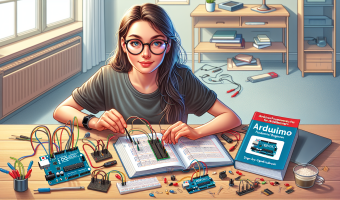Arduino Fundamentals for Absolute Beginners
About This Course
This is a free, beginner-friendly course designed to teach you the basics of Arduino from scratch — no videos required. You’ll learn how Arduino works, how to set it up, and how to create your first electronic project using clear text lessons, diagrams, hands-on tasks, and interactive quizzes.
Perfect for absolute beginners in electronics, coding, or makerspace exploration.
Learning Objectives
Understand what Arduino is and how it works
Set up and install the Arduino IDE
Write your first Arduino sketch
Build your first LED circuit
Read and modify basic Arduino code
Use simple electronics components
Test your knowledge with quizzes
Complete hands-on tasks with real feedback
Material Includes
- Downloadable Arduino sketches
- Circuit diagrams and wiring guides
- PDF cheatsheet for Arduino commands
- Step-by-step lesson texts
- Hands-on tasks and quizzes
Requirements
- No prior experience required
- A computer with internet access
- Optional: Arduino Uno board + USB cable
- Optional: LED, resistor, breadboard (for practical tasks)
Target Audience
- Complete beginners in electronics
- People who never used Arduino before
- Makers, tinkerers, and students
- Parents and teens exploring STEM
- Anyone curious about microcontrollers
Curriculum
16 Lessons4h 30m
Introduction to Arduino
Let’s start by understanding what Arduino is and what it can do for you as a beginner in electronics.
Installing the Arduino IDE
Before you can start programming Arduino, you need to install the Arduino IDE — the official development environment.
Blink: Your First Arduino Project
Let's build your first real Arduino project — make an LED blink!
Understanding Arduino Code Structure
Learn how Arduino code is structured and how setup() and loop() work together.
Working with Digital Output
Learn how to control components like LEDs, buzzers, and relays using digital pins.
Working with Digital Input
Learn how to use buttons and switches with Arduino and respond to user input.
Working with Analog Input
Learn how to read variable values from sensors using analog pins.
Working with Analog Output (PWM)
Use analogWrite() to control brightness, speed, and more with Pulse Width Modulation.
Final Assessment & Certificate
Take this final quiz to test your knowledge. Score 71% or more to earn your certificate!



